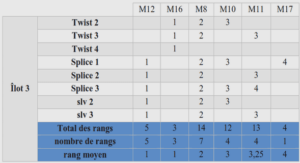MÉLANGES POLYMÉTALLIQUES
Les résultats présentés dans le chapitre précédent ont permis de montrer la diversité des toxicités des ETMs, en solutions synthétiques mono-contaminées. Comme tout élément chimique, ils interagissent avec leur environnement : on peut alors observer des phénomènes d’antagonisme, de synergie etc. C’est la raison pour laquelle connaître les single toxicities des ETMs n’est pas suffisant : il faut également créer des solutions plus complexes, tendre à mimer les concentrations réelles mesurées dans les échantillons de RITS, et évaluer les mixture toxicities. L’article qui suit présente les résultats des expériences menées en ce sens, avec la particularité d’avoir testé la sensibilité de la laitue Lactuca sativa ainsi que celle d’un crustacé dulçaquicole la daphnie Daphnia magna (dans le cadre de l’application de la DCE). Surface treatment industrial discharge water is a complex anthropogenic source of pollutants, including organic pollutants (PAHs, VOCs…) and numerous metal ions. We attempted to identify the main toxicants comparing impact assessment of real polycontaminated effluents and reconstituted polymetallic solutions via ecotoxicological bioassays performed with Daphnia magna immobilization test (24 h) and Lactuca sativa germination test (168 h). We focused first on 2 (Ni and Zn) then on 5 metals (Ni, Zn, Co, Cr, Al). Our results showed differences between metal toxicity order: Zn>Al>Ni>Cr~Co, for daphnids and Ni>Zn>Al~Co>Cr for lettuce. However, discharge waters remained more toxic than synthetic solutions: those 5 metals were not entirely responsible for the discharge water ecotoxicity. We also found D. magna to be more sensitive than L. sativa. This last assessment should be interpreted with care, knowing that immobilization and germination tests are respectively acute and chronic toxicity bioassays. Thus, battery tests are appropriate to evaluate industrial discharge water samples, and should be increasingly used as ecotoxicological standards.
Industrial discharge waters, especially those from the surface treatment (ST) industry, released into the aquatic ecosystems have their own set of various environmental and sanitary issues, due to the fact that various loads of hazardous substances including: metallic trace elements (MTE; mostly Zn, Ni, Cu, Cr, Sn and Al), organic matter (oils, solvents, etc. and diverse organics such as polycyclic aromatic hydrocarbons (PAHs) and volatile organic compounds (VOCs) [1]. ST industries are, like other industrial sectors, subject to specific release regulations, notably for metals. Although the discharge waters usually respect the regulatory standards, metals the present could be assimilated by fauna and flora and thus lead to long term toxic effects on the environment [2, 3]. Nowadays, while pollutant mixtures present in discharge water after treatment are relatively easy to characterize chemically, assessing their impact on the environment is usually difficult and has rarely been reported [4]. Finally, the toxicity of treated ST waste remains poorly defined.
water quality assessment are numerous and offer a large choice of indicators [5-7]. Three different types of standardized bioassays are the most commonly used, notably for the regulatory framework for chemicals management. They represent 3 trophic levels: primary producers with algae, primary consumers with crustaceans and secondary consumers with fish. Among them, the short-term bioassay based on the immobilization of a freshwater crustacean, Daphnia magna, is a test also used in the ecotoxicological assessment of industrial discharge waters. Nevertheless, it was pointed out that toxicity strongly relies on the choice of bioindicators and the endpoints used in the bioassays since sensitivity varies among taxonomic groups and species [8-10]. Consequently, it may be very useful to assess discharge water thanks to various bio-indicators in order to increase the ecological representativeness, to include a panel of sensitivity and to avoid a major risk of environmental effects and toxicity underestimation [11, 12]. Recently, phytotoxicity tests using plants such as Lactuca sativa have been also proposed to assess the impact of industrial effluents by our group for the first time [3]. Our results demonstrated that these tests were simple, quick and reliable. Moreover, the use of these bioassays also presented the advantage of being inexpensive and not requiring major equipment as also reported in other works [8, 10, 13]. However, these tests were mainly used to assess the toxicity of single substances, such as metals (Table III.5) and there is a lack of studies concerning the impact of complex matrices such as discharge waters [29] or synthetic solutions of several metals. The aim of this work was to assess the environmental impact of industrial discharge waters poly-contaminated with metals and to determine which metal(s) is Bioassays using Daphnia magna were carried out by an accredited analysis laboratory (CARSO, Lyon, France). The test was performed according to the “Inhibition Protocol Mobility” described in the standardized biomonitoring test ISO [31].



